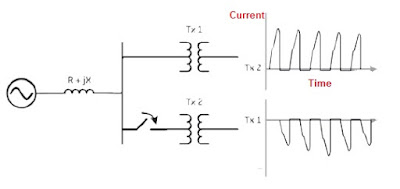I would suggest to read Transformer Inrush Current before reading this article for better understanding. Any event on the power system that causes a significant increase in the magnetizing voltage of the transformer core results in magnetizing inrush current flowing into the transformer. The three most common events are as follows:
Energization of the Transformer. This is the typical event where magnetizing inrush currents are a concern. The excitation voltage on one winding is increased from 0 to full voltage. The transformer core typically saturates, with the amount of saturation determined by transformer design, system impedance, the remnant flux in the core, and the point on the voltage wave when the transformer is energized. The current needed to supply this flux may be as much as 40 times the full load rating of the transformer, with typical value for power transformers for 2 to 6 times the full load rating. Figure below shows the waveform during energization of a transformer.
Magnetizing Inrush Current during Fault Clearing. An external fault may significantly reduce the system voltage, and therefore reduce the excitation voltage of the transformer. When this fault is cleared, the excitation voltage returns to the normal system voltage level. The return of voltage may force a dc offset on the flux linkages, resulting in magnetizing inrush current. This magnetizing inrush current will be less than that of energization, as there is no remnant flux in the core. The current measured by the differential relay will be fairly linear due to the presence of load current, and may result in low levels of second harmonic current.
Sympathetic inrush. Energizing a transformer on the power system can cause sympathetic magnetizing inrush currents to flow in an already energized parallel transformer. Energizing the second transformer causes a voltage drop across the resistance of the source line feeding the transformers. This voltage drop may cause a saturation of the already energized transformer in the negative direction. This saturation causes magnetizing inrush current to supply the flux. The magnitude of the magnetizing inrush current is generally not as severe as the other cases.
While charging a Transformer in Power System, harmonic restraining of other connected Transformers must be taken care as it may otherwise lead to the tripping of other connected Transformers.

